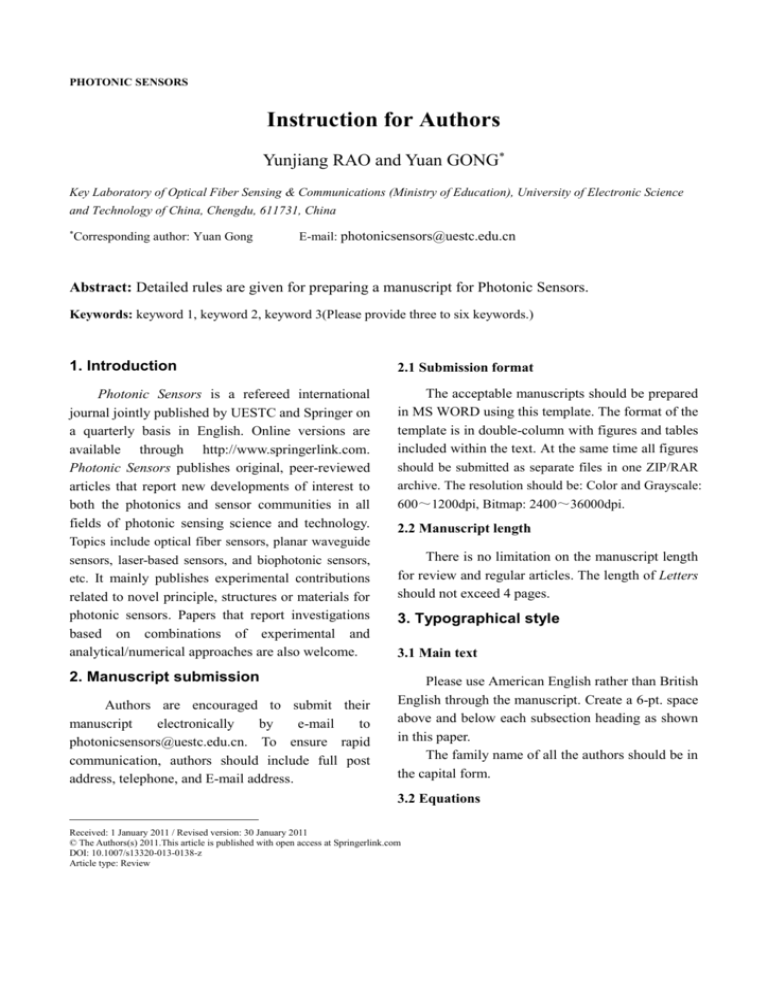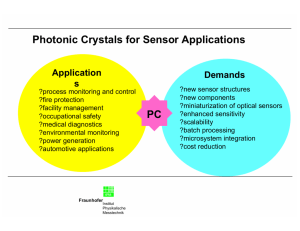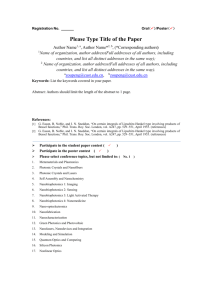Instructions for authors
advertisement

PHOTONIC SENSORS Instruction for Authors Yunjiang RAO and Yuan GONG* Key Laboratory of Optical Fiber Sensing & Communications (Ministry of Education), University of Electronic Science and Technology of China, Chengdu, 611731, China * Corresponding author: Yuan Gong E-mail: photonicsensors@uestc.edu.cn Abstract: Detailed rules are given for preparing a manuscript for Photonic Sensors. Keywords: keyword 1, keyword 2, keyword 3(Please provide three to six keywords.) 1. Introduction 2.1 Submission format Photonic Sensors is a refereed international journal jointly published by UESTC and Springer on a quarterly basis in English. Online versions are available through http://www.springerlink.com. Photonic Sensors publishes original, peer-reviewed articles that report new developments of interest to both the photonics and sensor communities in all fields of photonic sensing science and technology. Topics include optical fiber sensors, planar waveguide sensors, laser-based sensors, and biophotonic sensors, etc. It mainly publishes experimental contributions related to novel principle, structures or materials for photonic sensors. Papers that report investigations based on combinations of experimental and analytical/numerical approaches are also welcome. The acceptable manuscripts should be prepared in MS WORD using this template. The format of the template is in double-column with figures and tables included within the text. At the same time all figures should be submitted as separate files in one ZIP/RAR archive. The resolution should be: Color and Grayscale: 600~1200dpi, Bitmap: 2400~36000dpi. 2. Manuscript submission Please use American English rather than British English through the manuscript. Create a 6-pt. space above and below each subsection heading as shown in this paper. The family name of all the authors should be in the capital form. Authors are encouraged to submit their manuscript electronically by e-mail to photonicsensors@uestc.edu.cn. To ensure rapid communication, authors should include full post address, telephone, and E-mail address. 2.2 Manuscript length There is no limitation on the manuscript length for review and regular articles. The length of Letters should not exceed 4 pages. 3. Typographical style 3.1 Main text 3.2 Equations Received: 1 January 2011 / Revised version: 30 January 2011 © The Authors(s) 2011.This article is published with open access at Springerlink.com DOI: 10.1007/s13320-013-0138-z Article type: Review Photonic Sensors All equations should be created in MathType. Equations should be centered. Equations should have a 6-pt. space above and below the text. The equation number should appear only at the right hand margin of the last line of the equation: ( 1) E mc 2 All equations should be numbered in the order in which they appear and should be referenced from within the main text as Eq. (1). In-line math of simple fractions should use parentheses when necessary to avoid ambiguity; for example, to distinguish between 1/(n 1) and 1/n 1. 3.3 Figures Figures should be included directly in the document. All illustrations must be numbered consecutively with Arabic numbers. Figures must be inserted as objects that are fixed and move with the text, not as floating objects, see Fig. 1 for example. Intensity (dB) -20 -30 -40 -50 -60 1510 1530 1560 Wavelength nm) 1590 Fig. 1 Reflective spectrum of the hybrid fiber-optic Fabry-Perot sensor. Photonic Sensors does not accept multimedia files. All figure captions should be centered beneath the figure. Longer figure captions should be centered beneath the figure and alignment double (left and right) justified. The abbreviation “Fig.” for figure should appear first followed by the figure number and a period. Captions should be in 9- pt. font. At least one line of space should be left before the figure and after the caption. 3.4 Tables Tables should be centered and numbered consecutively. Authors must use Word’s Table editor to insert tables. Tables should use horizontal lines to delimit the top and bottom of the table and column headings. Detailed explanations or table footnotes should be typed directly beneath the table. Table 1 Refractive index versus temperature Temperature Refractive Number (°C) index 1 10 1.33 2 20 1.34 3 30 1.35 3.5 References References should appear in the order in which they are referenced in the body of the paper (see below). The font should be 10-pt. and alignment double (left and right) justified. Lines should be single-spaced. The words “References” should head the section (no number) in bold print followed by one blank line, directly above the first reference. Photonic Sensors uses numerical notation in brackets for bibliographic citations. At the point of citation within the main text, designate the reference by typing the number in after the last corresponding word [1]. Two references [2-3], should be included together, separated by a comma, while three or more consecutive references should be indicated by the bounding numbers and a dash [1-3]. The citation style can be found in the reference list. Appendix Appendixes, if needed, appear before the acknowledgment. Acknowledgment Sponsor and financial acknowledgments are placed here. support References [1] X. Zhang, Y. Lu, F. Wang, H. Liang, and Y. Zhang, “Development of fully-distributed fiber sensors 2 Yunjiang RAO et al.: Instruction for Authors based on Brillouin scattering,” Photonic Sensors, 1(1), 54–61, 2011. [2] D. Steup and J. Weinzierl, “Resonant THz-meshes,” The Fourth International Workshop on THz Electronics, Erlangen-Tennenlohe, Germany, Sept. 5–6, 1996. [3] J. Williams, “Narrow-band analyzer,” Ph.D. dissertation, Harvard University, Cambridge, MA, 1993. [4] J. P. Wilkinson, “Nonlinear resonant circuit devices,” U.S. Patent 3 624 12, Jul. 16, 1990. [5] R. C. Calfee and R. R. Valencia, “APA guide to preparing manuscripts for journal publication,” Salt Lake City: Academic Press, 1991: 1–3. [6] B. L. Shoop, A. H. Sayles, and D. M. Litynski, “New devices for optoelectronics: smart pixels,” in Handbook of Fiber Optic Data Communications, C. DeCusatis, D. Clement, E. Maass, and R. Lasky, Eds., Salt Lake City: Academic Press, 1997: 1–3. 3








